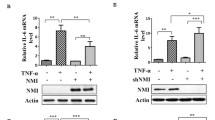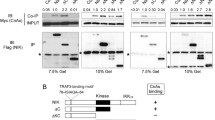Abstract
RIOK3 was initially characterized as a homolog of Aspergillus nidulans sudD and showed down-regulation at the invasive front of malignant melanomas, but the molecular mechanism remains elusive. Here, we report that overexpression of RIOK3 inhibits TNFα-induced NF-κB activation, but down-regulation of endogenous RIOK3 expression by siRNA potentiates it. A yeast two-hybrid experiment revealed that RIOK3 interacted with caspase-10, and further, a GST pull-down assay and endogenous coimmunoprecipitation validated the interaction. We subsequently showed that the interaction was mediated by the RIO domain of RIOK3 and each death effector domain of caspase-10. Interestingly, our data demonstrated that RIOK3 suppressed caspase-10-mediated NF-κB activation by competing RIP1 and NIK to bind to caspase-10. Importantly, the kinase activity of RIOK3 was confirmed to be relevant to NF-κB signaling. Taken together, our findings strongly suggest that RIOK3 negatively regulates NF-κB signaling pathway activated by TNFα dependent on its kinase activity and NF-κB signaling pathway activated by caspase-10 independent of its kinase activity.





Similar content being viewed by others
References
Angermayr M, Bandlow W (1997) The type of basal promoter determines the regulated or constitutive mode of transcription in the common control region of the yeast gene pair GCY1/RIO1. J Biol Chem 271:31630–31635
Geerlings TH, Faber AW, Bister MD, Vos JC, Raue HA (2003) RIO2p, an evolutionarily conserved, low abundant protein kinase essential for processing of 20S pre-rRNA in Saccharomyces cerevisiae. J Biol Chem 278:22537–22545
Anaya P, Evans SC, Dai C, Lozano G, May GS (1998) Isolation of the Aspergillus nidulans sudD gene and its human homologue. Gene 211:323–329
Angermayr M, Roidl A, Bandlow W (2002) Yeast RIO1p is the founding member of a novel subfamily of protein serine kinases involved in the control of cell cycle progression. Mol Microbiol 44:309–324
Vanrobays E, Gleizes PE, Bousquet-Antonelli C, Noaillac-Depeyre J, Caizergues-Ferrer M, Gelugne JP (2001) Processing of 20S pre-rRNA to 18S ribosomal RNA in yeast requires Rrp10p, an essential non-ribosomal cytoplasmic protein. EMBO J 20:4204–4213
Roesch A, Vogt T, Stolz W, Dugas M, Landthaler M, Becker B (2003) Discrimination between gene expression patterns in the invasive margin and the tumour core of malignant melanomas. Melanoma Res 13:503–509
Huang S, Pettaway CA, Uehara H, Bucana CD, Fidler IJ (2001) Blockade of NF-κB activity in human prostate cancer cells is associated with suppression of angiogenesis, invasion, and metastasis. Oncogene 20:4188–4197
Huang S, DeGuzman A, Bucana CD, Fidler IJ (2000) Nuclear factor-κB activity correlates with growth, angiogenesis, and metastasis of human melanoma cells in nude mice. Clin Cancer Res 6:2573–2581
Huber MA, Azoitei N, Baumann B, Grünert S, Sommer A, Pehamberger H, Kraut N, Beug H, Wirth T (2004) NF-κB is essential for epithelial-mesenchymal transition and metastasis in a model of breast cancer progression. J Clin Invest 114:569–581
Andela VB, Schwarz EM, Puzas JE, O’Keefe RJ, Rosier RN (2000) Tumor metastasis and the reciprocal regulation of prometastatic and antimetastatic factors by nuclear factor kappa B. Cancer Res 60:6557–6562
Li Q, Verma IM (2002) NF-kappaB regulation in the immune system. Nat Rev Immunol 2:725–734
Pikarsky E, Porat RM, Stein I, Abramovitch R, Amit S, Kasem S, Pyest EG, Shoval SU, Galun E, Neriah YB (2004) NF-kappaB functions as a tumour promoter in inflammation-associated cancer. Nature 431:461–466
Hayden MS, Ghosh S (2004) Signaling to NF-κB. Genes Dev 18:2195–2224
Li L, Shi Y, Wu H, Wan B, Li P, Zhou L, Shi H, Huo K (2007) Hepatocellular carcinoma-associated gene 2 interacts with MAD2L2. Mol Cell Biochem 304:297–304
Ma Q, Zhou L, Shi H, Huo K (2008) NUMBL interacts with TAB 2 and inhibits TNFα and IL-1β-induced NF-κB activation. Cell Signal 20:1044–1051
McCarthy JV, Ni J, Dixit VM (1998) RIP2 is a novel NF-kappaB-activating and cell death-inducing kinase. J Biol Chem 273:16968–16975
Schmitz ML, Bacher S, Kracht M (2001) I kappa B-independent control of NF-kappa B activity by modulatory phosphorylations. Trends Biochem Sci 26:186–190
Shikama Y, Yamada M, Miyashita T (2003) Caspase-8 and caspase-10 activate NF-kappaB through RIP, NIK and IKKalpha kinases. Eur J Immunol 33:1998–2006
Wang H, Wang P, Sun X, Luo Y, Wang X, Ma D, Wu J (2007) Cloning and characterization of a novel caspase-10 isoform that activates NF-κB activity. Biochem Biophys Acta 1770:1528–1537
Hanks SK, Lindberg RA (1991) Use of degenerate oligonucleotide probes to identify clones that encode protein kinases. Methods Enzymol 200:525–532
Stephens P, Edkins S, Davies H et al (2005) A screen of the complete protein kinase gene family identifies diverse patterns of somatic mutations in human breast cancer. Nat Genet 37:590–592
Payne AS, Cornelius LA (2002) The role of chemokines in melanoma tumor growth and metastasis. J Invest Dermatol 118:915–922
Schaider H, Oka M, Bogenrieder T, Nesbit M, Satyamoorthy K, Berking C, Matsushima K, Herlyn M (2003) Differential response of primary and metastatic melanomas to neutrophils attracted by IL-8. Int J Cancer 103:335–343
Leslie MC, Bar-Eli M (2005) Regulation of gene expression in melanoma: new approaches for treatment. J Cell Biochem 94:25–38
Daniotti M, Oggionni M, Ranzani T et al (2004) BRAF alterations are associated with complex mutational profiles in malignant melanoma. Oncogene 23:5968–5977
Chaudhary PM, Eby MT, Jasmin A, Kumar L, Liu L, Hood L (2000) Activation of the NF-kappaB pathway by caspase 8 and its homologs. Oncogene 19:4451–4460
Bodmer JL, Holler N, Reynard S, Vinciguerra P, Schneider P, Juo P, Blenis J, Tschopp J (2000) TRAIL receptor-2 signals apoptosis through FADD and caspase-8. Nat Cell Biol 2:241–243
Jun JI, Chung CW, Lee HJ et al (2005) Role of FLASH in caspase-8-mediated activation of NF-kappaB: dominant-negative function of FLASH mutant in NF-kappaB signaling pathway. Oncogene 24:688–696
Ghosh S, Karin M (2002) Missing pieces in the NF-κB puzzle. Cell 109(Suppl):S81–S96
Jones SA, Butler RN, Sanderson IR, Wilson JW (2004) The effect of specific caspase inhibitors on TNF-alpha and butyrate-induced apoptosis of intestinal epithelial cells. Exp Cell Res 292:29–39
Goepel F, Weinmann P, Schymeinsky J, Walzog B (2004) Identification of caspase-10 in human neutrophils and its role in spontaneous apoptosis. J Leukoc Biol 75:836–843
Acknowledgments
We thank Dr. Karen Dawson for proofreading the manuscript. This study was supported by the Chinese 863 program (2006AA02A310) and Chinese Human Liver Proteome Project (2004BA711A19) to K. Huo.
Author information
Authors and Affiliations
Corresponding author
Electronic supplementary material
Below is the link to the electronic supplementary material.
Supplementary Fig.1
Interaction between RIOK3 and caspase-10 in yeast two-hybrid system. Plasmids were cotransformed into yeast Y190 cells and plated on an SD/-Leu-Trp plate (upper) or an SD/-Leu-Trp-His plate with 30 mM 3-AT (middle). Blue colour due to expression of β-gal protein is indication of positive protein–protein interaction (bottom). I, pGBKT7-RIOK3+pGADT7 II, pGBKT7-RIOK3+pACT2-caspase-10 III, pGBKT7+pACT2-caspase-10. Supplementary material 2 (TIFF 3474 kb)
Rights and permissions
About this article
Cite this article
Shan, J., Wang, P., Zhou, J. et al. RIOK3 interacts with caspase-10 and negatively regulates the NF-κB signaling pathway. Mol Cell Biochem 332, 113–120 (2009). https://doi.org/10.1007/s11010-009-0180-8
Received:
Accepted:
Published:
Issue Date:
DOI: https://doi.org/10.1007/s11010-009-0180-8




